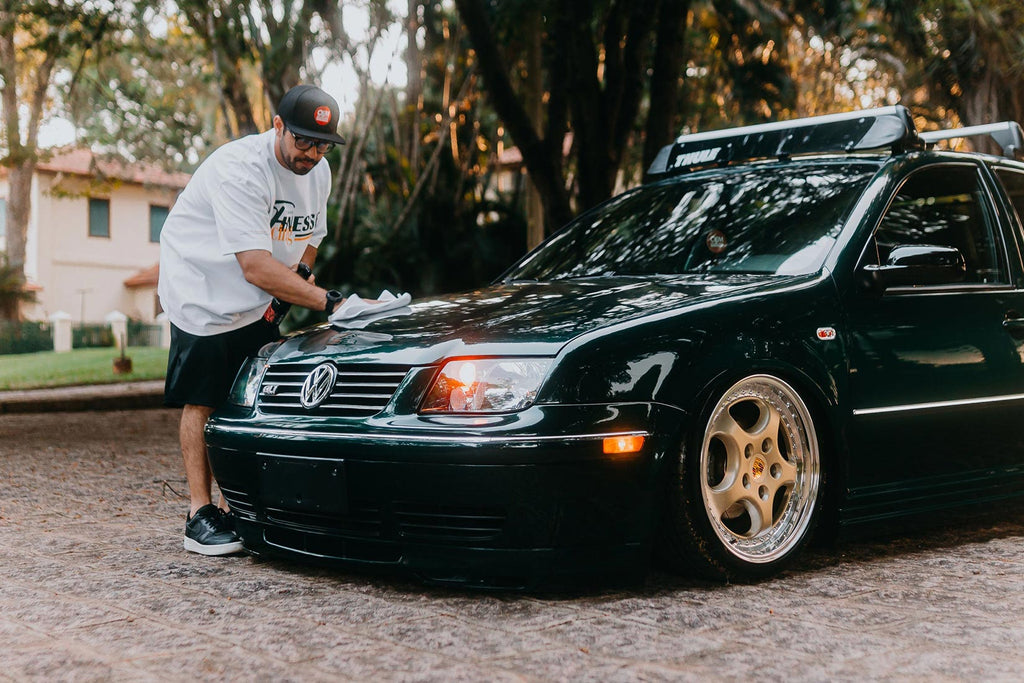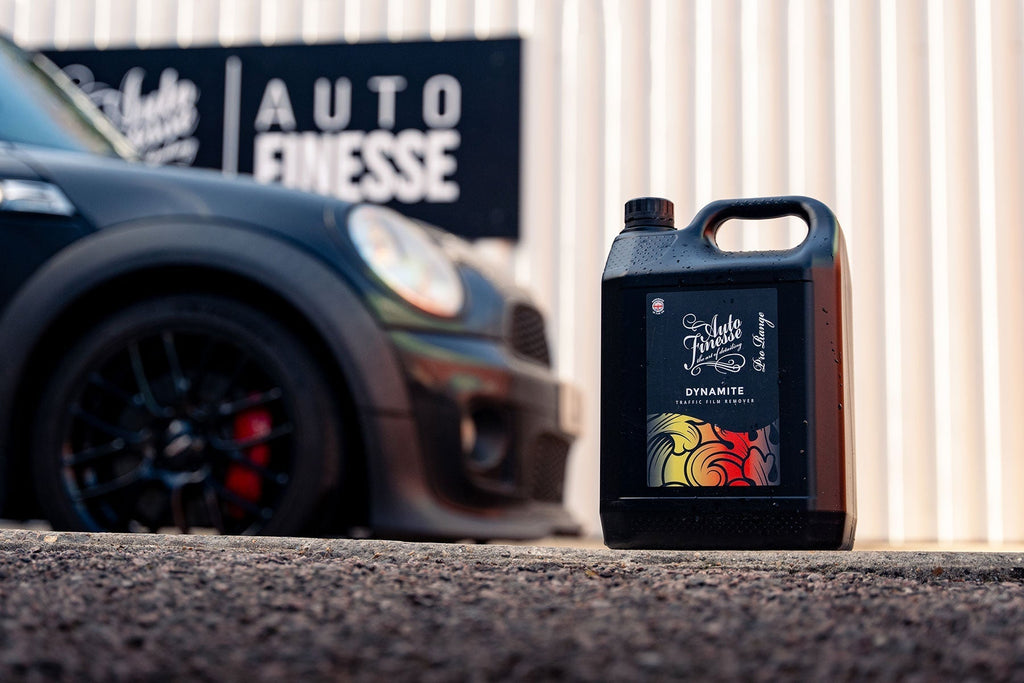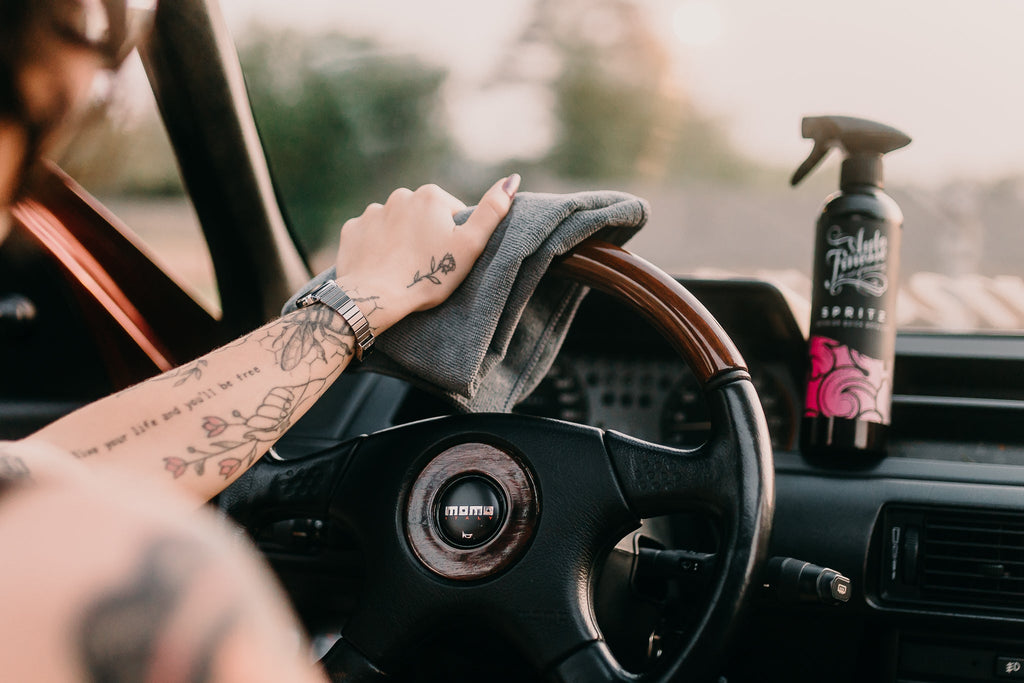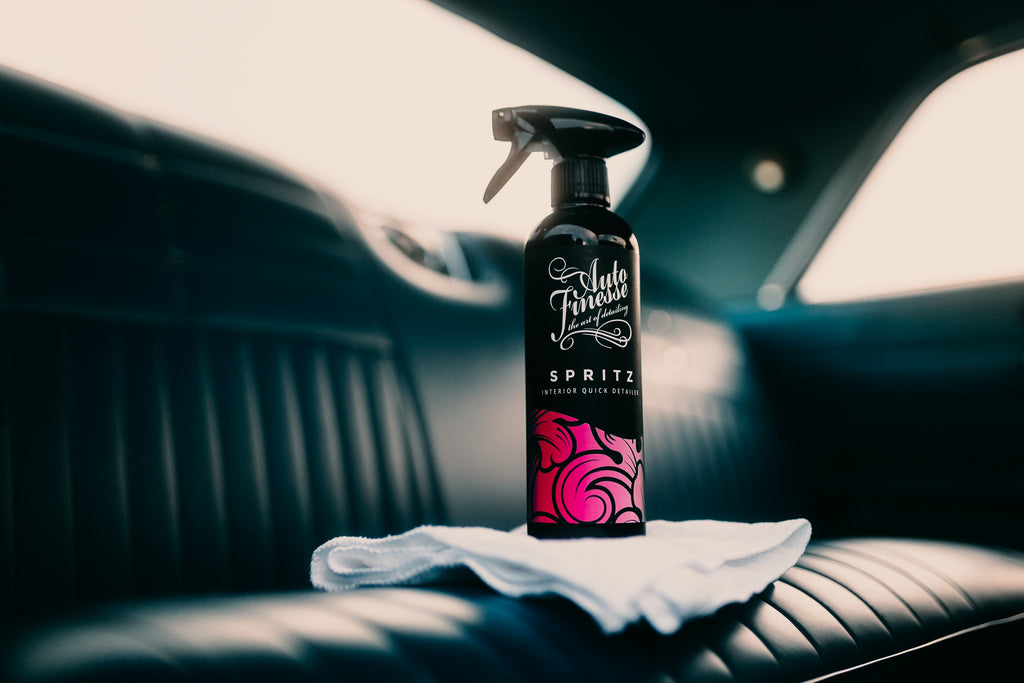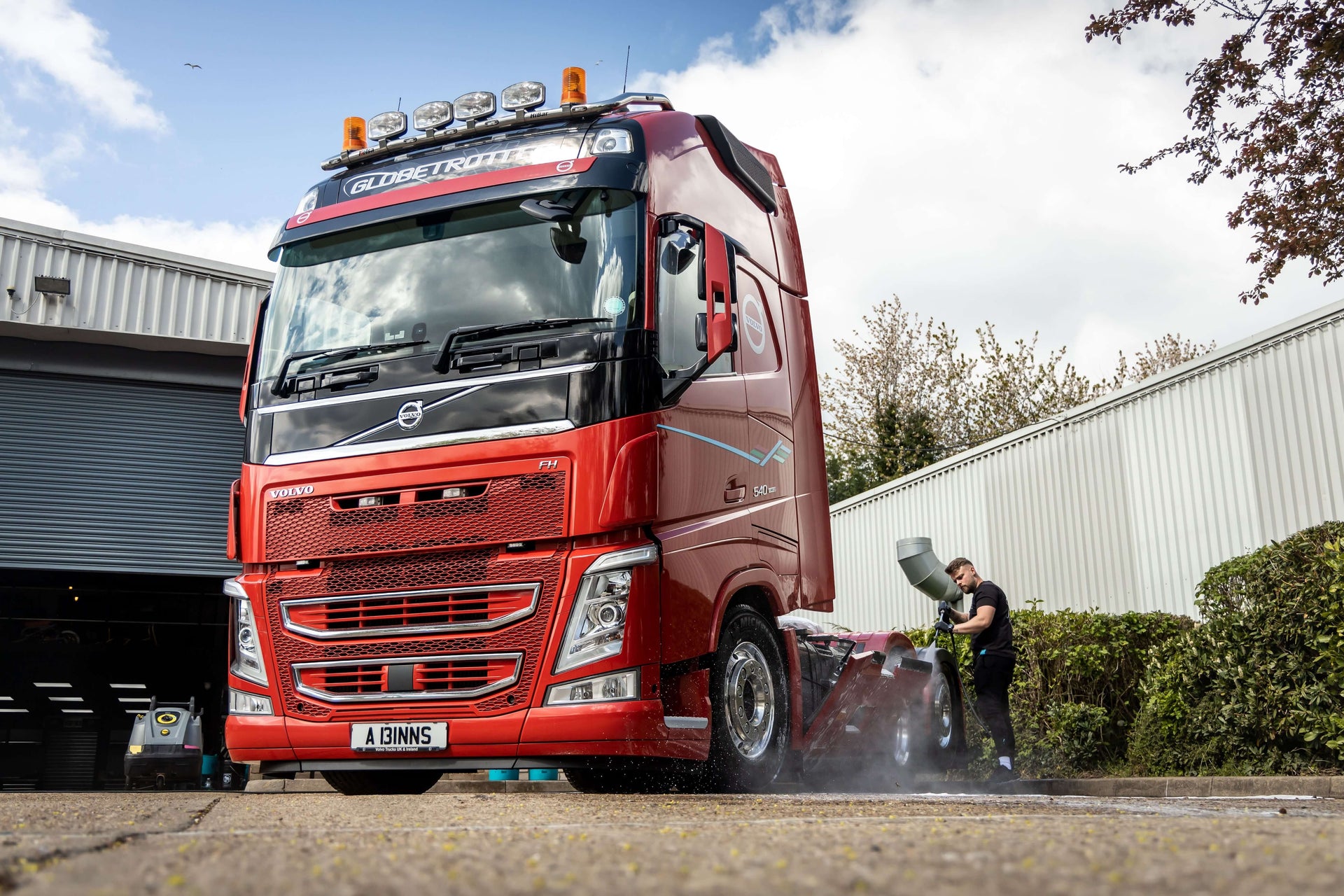How To Detail a Truck

IN THIS FREE GUIDE:
- Learn how to detail a truck and the really big stuff!
- Discover how to adapt your processes and techniques to cater for all sizes of vehicle.
- See the essential products to use along the way, and how to utilise them for maximum effectiveness.

WHAT ARE THE BENEFITS?
- Learning the professional-level processes used for large vehicles means that you can detail anything.
- Safely adapting your wet work and paint enhancement techniques to specific tasks helps you master the art of detailing.
- Knowing the products to use, in which order, gives you the best grounding in the detailing fundamentals.
Yes, it's a big one, but it's not unlike detailing a car… only with a few key differences.
Trucks, load luggers, tractor units, rigs, semis, lorries, road trains, whatever you like to call them in your region, HGVs keep the economy of entire nations moving. In fact, here at Auto Finesse we don't just pick and ship thousands of direct orders every day, we also load up multiple HGVs, cramming them with even more of our top detailing products for distribution all around the world.
But, as for actually working our own brand of supreme detailing magic on a lorry? That's a completely different animal. Due to the nature of being constantly on the road munching up the miles, it has to be said that we don't get to break out the polishers on one of these very often. But we guess that the big question here is why would you actually detail any HGV in the first place?
Well, as always, the answer is simple, even if the process is a little more involved than usual. HGVs need every bit as much love, attention and protection as cars, they're just as susceptible to day-to-day contamination and the onset of corrosion as any other vehicle on the road, likely even more so due to the hard working life and extreme mileages these monsters have to endure.
Of course, there's another practical reason why they need to look the part. They may they put in the miles in all weathers but, just like a company car or indeed a detailing van, a lorry offers the face of the business out there on the road - the better they look, the better it is for the reputation of the owner. In fact, you'll find that due to the huge mileages involved, HGVs tend to be cleaned regularly to uphold the company image. In some cases these are run through a truck stop wash multiple times every week.
But, and here's the important bit, the usual truck washing may not necessarily be carried out in the safest way, so while you may see many a clean lorry at a distance, look a little closer and you'll discover that most are in dire need of enhancement, not to mention proper protection that makes safe cleaning far easier the next time around. So, that's what we'll be doing here by drafting in our friends over at A C Binns Transport Services to give one of their recently-purchased Volvo 540 FH cabs an AF style overhall…

What makes HGV detailing different?
The Volvo FH Series, like the Swedish juggernaut we've got here, is actually one of the most successful trucks to ever hit the road and, although at around 18-tons just for the cab (and up to 120-tons fully loaded) you'll be forgiven for thinking the FH stands for "something heavy', it actually means "Forward control High entry' denoting that it's the big, long-distance rig with the high cab, specifically designed for pulling the largest, heaviest trailers. This particular 540 model is also sporting a 13-litre turbo diesel lump with 540bhp and a whopping 2600Nm of torque… not in the slightest bit relevant here of course, but pretty impressive none the less.
But, how do you actually detail one of these? Well, that's the big question, isn't it? Although, on the face of it, most of the products and processes are much the same as with a car, there are a few things unique to vehicles of this size to look out for. And, adapting the detail to suit is what this guide is all about.

Now, apart from the obvious bit - these things are absolutely massive - there are areas on HGVs that always need a little extra consideration. For the most part you'll find far more large plastic panels, such as wheel tubs, side panels and aero. This becomes important when machine polishing because plastics dissipate heat slightly differently to metal. Speaking of metal, trucks tend to have far more accessible (and hence noticeable) random metal parts on the exterior, too. Some, like the open chassis rails, are painted or powdercoated and others - a heady selection of guard plates and other panels - will be bare steel or aluminium. As with all polishing processes it's important to know exactly what you're dealing with and what specific products to use.
It goes without saying that you'll find that there far more nooks, steps, large grilles, intricate opening panels and bolted chassis areas than you would on a car, all of them offering potential dirt traps that can come back to haunt in the later stages of the detail. And perhaps the biggest difference you'll find is that the vast majority of trucks use singe stage paintwork from the factory. In most cases clear coating is an expensive special-order option that many hauliers simply do without. Understandably you'll also find that many are repainted when they change ownership, and when they aren't, you'll often find evidence of sun fading around old company decals that have been removed. These may require more intense polishing to ensure that the colour is uniform throughout.
As for the most important question of do you need different products to do the job effectively? The answer is no. Aside from using the odd stronger dilution, like you would on any heavily-soiled vehicle, all the wash, decontamination, polishing and protection products used are exactly the same as you'd use on a car. In other words, our detailing products work on any vehicle, big or small.



What About the Wash History?
When it comes to paint correction and swirl marks, the last thing to look at is how trucks tend to be cleaned. Aside from the (often-increased) frequency of washes, you'll find far more defects caused by risky techniques than those that originate from day-to-day driving. While it's true that trucks are bigger than cars and vans, and this makes them more susceptible to brushing from trees and hedges, the vast majority of defects come from regular washing using a splash down and long brush, automated truck washes or simply not carrying out an effective pre-wash and snow foam before making contact with paintwork.
It's also obvious that many HGVs aren't dried properly (by soaking up the water with a dedicated drying towel) after the wet work and this means that watermarks, caused by impurities in the wash water, tend to be rife… but all these problems can be overcome using the correct products and a little finesse…

The Biggest Detail
Now, with many processes so similar to what you're used to when detailing your car, a traditional step-by-step guide would be pretty futile here. So, instead we'll focus on the main differences in processes that are unique to this kind of job, and explain exactly how and why they're carried out. That said, if you're looking for a general guide on safely cleaning your car - check out our in-depth article - How To Wash Your Car Safely: The Definitive Guide. For further detailing be sure follow through the stages of decontamination and polishing with our guides - How To Safely Decontaminate Paintwork and The Basic Guide To Machine Polishing. In the case of this particular detail though, while most of the processes are similar, we'll show you exactly how they may differ.
First thing's first though, and that's knowing where to start. There is one large area on any HGV cab that shouldn't be cleaned at all and that's the main trailer hitch. These require a thick layer of grease on top to prevent friction and it stands to reason that you don't want to clean this off, or even worse, spread it around the rest of the vehicle. Using a piece of plastic sheeting to cover this area can eliminate the chance of any costly mistakes during your wet work, or in the later detailing stages.
With that protected, it also pays to have a good look around the vehicle to ascertain exactly what you're dealing with, opening any side panels, front grilles and steps that may need a little extra attention. Remember that, in detailing, planning is everything.
It goes without saying that you'll need to avoid doing this job on a hot day, too. Especially if you happen to be working alone. This will help prevent premature drying - don't forget that there's a hell of a surface area to cover here, and there's not a canopy big enough to shield this one from the sun. As with any vehicle, if in doubt, always keep it wet until you're good and ready to break out the drying towel, there's no sense in making the job more difficult, is there?

Wheels and Tyres
As with any detail, to prevent the transference of heavy grime to cleaner areas of the vehicle, we begin with the dirtiest parts, namely the wheels and tyres. The only real difference with detailing an HGV is that these bits are predictably gigantic - and that there tends to be significantly more of them. In fact, without specialist equipment and some serious muscle, you can't even take them off. These can weigh in at anything up to 80Kg a pop!
The good news is that all the usual wheel cleaning rules apply here, and the product (or products) you use will always be dictated by the construction and finish of the wheels you're cleaning. As with cars, the materials and finishes used vary from truck to truck, so for a full rundown of the best products for cleaning different types of wheel, see our article - The Definitive Guide To Cleaning Alloy Wheels.
When it comes to those gargantuan tyres, that's a little more straightforward. After a thorough pre-rinse, a few spritzes of our super-powerful Tread Tyre Cleaner and a good helping of mechanical cleaning action using our stiff, Rubber Scrubber Tyre Brush, is all you need to remove even the most ingrained road grime and traffic films, along with the hardiest embedded brake dust. In fact, it's the latter - the dreaded brake dust - that is perhaps the most important consideration throughout the whole wheel and tyre cleaning process on any HGV.



Overall, the main thing to remember is that massive wheels and tyres on a big, heavy vehicle means equally enormous brakes. In turn, huge brake pads tend to churn out plenty of brake dust, far more than you'll find on any car. Brake dust is essentially made up of sharp metal particles that embed themselves into surfaces and require cleaning products powerful enough to lift and encapsulate them, allowing them to be safely rinsed away. This is the main reason why powerful wheel cleaners are designed as for your wheels only, rather than general use on the rest of the vehicle.
In our case though, there's the added consideration that the wheels on this Volvo Cab are rather posh, polished metal items, a relatively sensitive finish that you may not expect to find on such and industrial workhorse. With this in mind, it's essential that we steer clear of any heavy-hitting decontamination products designed purely for chemically dissolving metals, simply to cut the risks associated with deep-cleaning on this type of finish.
The answer here, as it is in most cases, is a combination of our acid-free Imperial Wheel Cleaner, brushed in with a bucket of Revolution Wheel Soap solution. Both these dedicated wheel cleaning products are not only safe to use on this type of finish but are also capable of intense brake dust removal without having to resort to using strong chemicals at either end of the pH scale. Here we also made use of our super-soft Wonder Wool Wheel Brushes and scratch-free Detailing Brushes, and a dedicated, soft wash mitt, which are all perfect for use on the most sensitive surfaces.

Imperial is a spray-on product that's supplied ready-to-use in 500ml bottles (at a 1:10 dilution) and powerful enough to take care of the vast majority of wheel cleaning tasks. But, there's also the option of utilising our 1-Litre or 5-Litre Imperial Concentrate. The advantage here is that they're dilute-to-suit, meaning you can use a dilution of up to 1:2 for the heaviest, caked-on grime and brake dust, or down to 1:20 for maximum economy on lightly soiled, protected wheels.
In our case we opted for the concentrate form (still diluted at 1:10) and we used our Pressure Sprayer to not only mix up our cleaning solution, but to take all the effort out of spraying all around the six ridiculously large, intricate wheels. A relatively simple spray, agitate and rinse affair.



The Wet Work
The wet work, or wash stages - from the pre-rinse right through to the contact wash - are the most important part of any detail, we say this time and time again. More specifically though the pre-wash and snow foam stages are seen as the most crucial because it's here where you remove the majority of potentially harmful grime before physically touching the vehicle with your wash mitt. It's all about damage limitation, you see. Avoiding inflicting any swirl-marks and other paint defects as you clean the surfaces.
When washing an HGV though, rather than performing all the wet work from the top down over the whole vehicle, we split the stages over two areas - the cab and the chassis. Depending on the level of soiling, the pre-washing process can be performed slightly differently for each area. This "divide and conquer' method also helps avoid premature drying over the vehicle because, let's face it, there's a lot of surface area to cover as you wash.
The idea, as always, is to start with the grimiest area (the chassis bed) to prevent grime being transferred to cleaner areas. It's also notable that the cab area is the most noticeable part of any HGV, with the majority of large painted panels most susceptible to obvious scratching and water marks, so it's advisable to leave the cleaning here until last.
Thoroughly pre-rinsing is equally important on each of these areas, before applying any cleaning products. Getting in there first with your pressure washer not only removes the loose grime, meaning that your cleaners can get to work where they're actually needed on the bonded grime. But, flushing out panel gaps, chassis rails and other awkward areas as much as possible at the same time also prevents any grime from seeping out later and interfering with the rest of your detail. As you can imagine, large gritty particles whizzing around on your polishing pad are going to do way more harm than good, right?
But, how is the wet work on each area different? Well, on a lightly soiled truck chassis like this one the sometimes it pays to use a little extra agitation to ensure all parts are reached. Here we're talking seriously intricate areas which are a lot like an engine bay, so making sure that your pre-cleaner reaches every little nook and recess is vital. Using a suitable pre-cleaner is also crucial, here we're using Citrus Power Bug and Grime Remover to lift and encapsulate the grime, and for ease of use on such a large area, once again we've utilised another Pressure Sprayer. Citrus Power is supplied ready-to-use, but you can also opt for our dilute-to-suit Dynamite Traffic Film Remover here, adapting your dilution for the specific level of soiling.



The same can be said for your snow foam stage, and on this job this is where the agitation side comes in. Snow Foam is likely the biggest detailing essential when dealing with seriously large vehicles, especially HGVs. Avalanche, our citrus-infused signature Snow Foam, has been developed to not only dwell to work on the baked-on grime for as long as possible, keeping the vehicle wet, but will also work its way into all the recesses. Combined with our Snow Foam Lance, it's perhaps the ultimate pre-cleaning combination.
That said, as just as you would on the more intricate areas on a car - dirt traps such as along window rubbers, grilles and fuel flaps, a little agitation helps it along its way to reach every area, and help to move away "spent' solution (the Avalanche already encapsulating grime) and replenish it with fresh solution to work on any remaining grime. When it comes to these small areas on a car we use a Detailing Brush to agitate, the only difference here is that we need to scale up the operation!
On the HGV chassis we can agitate the snow foam using a Noodle Mitt, these are specifically designed with long microfibre fingers to get extra access into every recess, picking up and locking way grime in the deep pile. In this case we also use Lather Car Shampoo as an extra cleaner and lubricant, to add extra grime-shifting ability and a good degree of safety when removing particulates. So, while it appears that we're snow foaming and contact washing at the same time (and in a way we are), the real story here is that were effectively agitating the snow foam into the more intricate areas using a lubricant before rinsing away the grime.



When it comes to the cab, lightly soiled or not, this should always be treated exactly like a car, rinsing from the top, flushing out any panel gaps and other dirt traps before applying any cleaning product. Like a car too - where you may start with a little Citrus Power agitated with a detailing brush into awkward areas like the door jambs, fuel flap and the like - we're tackling these intricate areas first… only working on a much larger scale.
The Volvo Cab has several flip out front steps along with a front panel for the radiator (much like a car engine bay), so we opened them up first and agitated in our pre-cleaner and rinsed, before applying Citrus Power to the rest of the exterior, starting with the lower, dirtier areas for extra dwell time, and finishing at the top.

After another rinse, it's on to the all-important snow foam stage, applying Avalanche from the top down. Once again, the thick, lingering foam is designed to be left to dwell for as long as possible to help it effectively lift and encapsulate particulate grime and other bonded contamination. The only mistake to avoid, especially on a massive truck, is letting the solution dry out. As on any detail, too, Avalanche can also be lightly agitated into the more intricate areas like grilles, around wing mirrors and window rubbers. Only when the snow foam (along with the grime) is rinsed away thoroughly, can you make a start on your two-bucket contact wash using Lather Car Shampoo as your cleaning agent.



Contact Washing
Using two Detailing Buckets, washing in straight lines and working on the cleaner areas first are the rules of thumb for any detail, and nothing changes here. The only advantage of an HGV of course is that are limited up facing surfaces due to the boxy shape, so we can simply work our way from the top down. Starting with the roof and finishing on the lower sides and rear. One thing that goes without saying here is that access is vital, as you need to avoid cleaning with a long brush opting instead for a proper wash mitt to pick up and lock away the grime, just like the Plush Wash Mitt, we're using here. Obviously we're using industrial steps to do the job, but at the very least you'll be needing some ladders for all the cleaning, polishing and finishing stages.
And, as for your Lather Car Shampoo? Well, again this contains powerful surfactants designed to physically pull grime away from surfaces, safely locking it away in the solution, meaning you can rinse away the contamination without the fear of abrading sensitive surfaces like paintwork and gloss plastics. Packed with advanced lubricants to help potentially harmful particles glide across surfaces without scratching, you can adapt your dilution to any cleaning task.



Decontamination
When any sort of polishing is on the cards, especially on a vehicle like this that's not adverse to racking up the milage, a full-3 stage decontamination is necessary to remove the embedded contaminants that simply can't be eradicated by washing alone. The process here is exactly the same way as the one you know and love, although it's worth noting that the contaminants in question will usually be a little more concentrated than on your average daily driver.
A lot of this of course, is down to the actual design of a cab-over-engine truck. With a big, flat-fronted lorries it makes sense that the front end will suffer the most, particularly from metal shrapnel impregnation that comes from brake dust floating in the air on fast motorways and A-roads - the natural habitat of the HGV. In this way it's not just the brake dust that comes from the vehicle itself that needs to be eradicated in the first stage of your decontamination, but the fallout from just about every other vehicle on the road. This is the reason why ferrous metal decontamination isn't just important around the wheel areas and the sides, but everywhere else, too. In many cases the particles are too small to see, but they'll still do damage on your polishing pad, so it's vital to be thorough, and decontaminate every surface that's to be polished.
In any case, metal shrapnel is hardy stuff, when it's fully embedded it requires chemical removal, or dissolving into a solution, to get it out of the surfaces. This is where Iron Out Contaminant Remover comes in, this product is safe to use on paintwork and trim, and it quickly reacts with the contamination, turning the solution blood red to create a solute of Iron Out and ferrous metal that's easy, and more importantly safe, to rinse away.


Further decontamination should be carried out, as you would any other vehicle, first using ObliTARate Tar & Glue Remover, a powerful solvent designed to dissolve sticky residues, tar and road rash, allowing them to be wiped from the surface with a clean microfibre cloth. After a wash down to neutralise the solvents, this is followed by using a Clay Bar and Glide Clay Lube over the whole vehicle to remove bonded contaminants, such as protein deposits from bugs bird droppings and mineral deposits from water and tree sap. This process is vital because this type of bonded contamination can build up on unprotected surfaces over time, and even the smallest particles can slowly eat away at your paintwork, or interfere with your polishing. In fact, after claying you can actually feel the difference, so it's crucial to ensure every surface that's to be polished has first been decontaminated using detailing clay. The only real difference in the process you'll notice here is that, because it's such a large vehicle, we thoroughly dried the whole lot before performing the clay stage. This is simply to prevent the rinse water from drying while we're working elsewhere.
Normal tap water, the stuff you probably use to wash your car, isn't pure, it's actually a solution that contains all sorts of deposits. These impurities will be left on surfaces if the water part of the solution is allowed to evaporate off naturally. Limescale and other mineral deposits left on surfaces are what causes water marks, and in some cases, these need polishing to be removed. This is why we always use a dedicated drying towel - such as our Aqua Deluxe, Aqua Deluxe XL or Silk Drying Towel - to physically absorb the water and the deposits together, to prevent anything being left behind on the exterior surfaces. It's also the reason why it's vital to dry your car, or any other vehicle after every wash, no matter if you're planning on carrying out any further detailing stages.
Anyway, as we said, we carried out the clay stage after drying, and to be honest you can do the job this way around when decontaminating a car, too. Many pro detailers prefer to do it this way.



Polishing
When it came to the machine polishing, or more specifically the enhancement, portion of the detail, we may have had a whole team on it, but you could do this yourself, it'll just take a little, or quite a lot, longer. What's most important here though is that we were varying the products used for specific sections of the paintwork. In other words, it's all about testing and finding out what combination of abrasive and machine polishing pad works to get the desired result.
The difference between a car and a truck is that, generally speaking, cars are more uniform in their finish, although you may have the odd plastic bumper or spoiler to contend with, for the most part you're polishing metal panels that are have the same paint finish and are often suffering from the same wash defects. Trucks however have other areas (for instance the chassis bed and front panel) which may have a different finish and may be made from different materials that react slightly different to heat when polishing. There's a whole lot more intricate areas to contend with, too. It's important to take this into account and test for each area when looking the correct products to use. Trucks are, after all, designed to be hardcore load luggers, not show cars.
As we said, it's also rare for an HGV to be fully clear coated, so don't be surprised to see a little pigment transfer on your polishing pad, too.




Obviously, we had the entire Auto Finesse arsenal at our disposal here, with plenty of Revitalise Machine Polishing Pads and Revitalise Spot Pads to choose from, so we'll be the first to admit that we're always a little spoilt with our DPX and MPX Dual Action Machine Polishers. We also have both our collection of coarse (restoring) medium (polishing) and fine (refining) Revitalise System Compounds, some new Pro-Series compounds we're currently testing (which you may have noticed popping up on the video), and our advanced One Step All-in-One Compound which uses special diminishing abrasives to start off as a coarse cutting compound and finish down to near flawless by breaking down to a fine finishing compound as you work.
The point is that all these products have various grades and characteristics to take care of the cutting and refinement stages needed to get the desired result. They also contain no waxes or fillers, so while they can be used with a wax or sealant layer for the final protection, they also offer the true finish essential for the application of an Si02 based ceramic coating, like the one you'll find in our 12-month durable Caramics Paintwork Protection Kit. Ceramic coatings bond chemically, and this means that there should be no waxes or fillers left behind on the surface to get in the way of this process.



In this case too - simply because we'll be using wax-based products for protection later (and we'll explain why when we get to the protection bit) - we could also utilise our Tripple All-in-One Polish for enhancement, a product that cleans, polishes and protects in one by using light abrasives and deep cleaning solvents, and leaving behind a layer of Brazilian Carnauba Wax. Tripple breaks down easily so while it can be used via your machine polisher, it's also ideal for hand polishing - pretty useful on any vehicle, especially one like this with plenty of intricate areas offering limited access, such as inner panels and fuel tanks.



So, the big question then, is what's the best product and pad combo to use for an HGV paintwork enhancement? The answer is simply the one which works best on each specific area. That's exactly where your testing comes in.
The idea of any polishing is to level down the surface to cut out the defects, or more specifically to remove the entire surface around the defect until the bottom of the deepest defect is reached. The trick is to use an abrasive heavy enough to cut away the scratch or swirl mark, or restore the paintwork, but without using one that's so coarse it creates even more work. The lighter the abrasive you can use, the less work it is, and the less stages you'll need to fully refine the finish down… just as long as it rids the surface of the defects. A simple case of "just enough' to do the job. So, when you're testing you start off with the lightest compound, and step it up if there's not enough cut. And remember that while one area may require one combo for this specific job, it's not necessarily going to be exactly the same as one you may need to use on your car, or any other job. In detailing each task is specific - that's the art!
For more information on how polishes work, and what ones to choose for specific tasks, check out our full article - All Car Polishes Explained. You can also find out more about polishing pads in our guide - Polishing Pads : What You Need To Know.

It's also worth noting that the paintwork isn't the only area that required polishing on our Volvo, there's a whole load of bare metalwork - including the huge rear chassis guards and all six wheels - that were in need of attention, too.
Mercury Metal Polish is our product of choice here, it's safe for use on all bare metal surfaces and uses advanced abrasives to effortlessly remove oxidation, light defects and tarnishing. Easily broken down, again this product is suitable for use with a machine polisher, but also great for hand polishing the most intricate areas. If anything, the bare metal areas on this HGV are intricate to say the least!
Mercury is powerful stuff, there's no doubt about it, but we also have Mercury Xtreme Metal Polish, a staple of the range which uses a slightly heavier abrasives capable of taking on the really mucky stuff.



Protection
Once the paintwork had been corrected and enhanced, just like any other detail, it was essential to add suitable protection. This process not only safeguards your work by creating a barrier to the elements, but it also adds shine to the surfaces by allowing the light to bounce back to your eye more uniformly, this gives the impression of increased depth and gloss.
Now, for hardcore daily drivers and work vehicles such as this, we'd normally opt for a ceramic coating, as these give the hardiest durable protection and easy-clean properties. In this case however, we're going for maximum looks, as the HGV was scheduled to attend a big truck show following the enhancement. Just another example of how detailing processes may be adapted for specific jobs.
In any case this explains why we'd be using a wax, or more specifically two layers of our Illusion Show Wax (part of our Signature Collection of hard waxes) to add our protection on the painted exterior panels. This, in a way, starts to make the distinction between road-ready hauler and show-ready spectacle.
Waxes level the optical finish of exterior surfaces in much the same way as ceramic coating or sealants - they smooth out any microscopic ruts and recesses, to create a level surface that's better suited to uniform light reflection. The difference with a natural wax, rather than a man-made layer which will be perfectly clear, is that they contain certain natural impurities that absorb and refract light - this is what gives them their trademark warm glow. It's also one of the reasons why we honestly believe that, for looks, a wax can't be beaten. Illusion also offers up to 3-months hardy protection.



For other painted areas, especially those inside the doors, side aero panels, and others that were a little more awkward, a quick spritz of our Glisten Spray Wax and a wipe is all that's needed for acres of shine and up to 4-weeks of protection. Glisten can even be used on gloss plastics and, in our case, the copious polished metal panels and kick plates. A quick, easy and effective way to not only add wax protection, but to top it up on every maintenance detail, too.

Wheel Protection
Aside from the exterior paintwork, we've already mentioned just how susceptible these relatively sensitive, bare metal wheels are to the dust flying off those massive brakes. With this in mind it makes sense that these would need plenty of protection too.
Following the super-shiny wax theme we reached for the Mint Rims Wheel Wax, a wax with a difference and one that's we've developed specifically for all types of vehicle wheels. Rather than containing natural waxes, this product is made up of synthetic waxes designed to stand up to extreme temperatures. To put it simply, wheels get hot, and airborne brake dust is even hotter, so while this product is just as easy to apply as a normal hard wax and offers a high gloss finish, it's specifically designed to stand up to maximum abuse. In fact, because Mint Rims is so effective at stopping corrosive brake dust from sticking, it will make the wheels seriously easy to clean during routine maintenance, too. It also lasts for up to 3-months before any reapplication is needed.

Interior Detailing
You may not have seen it on the video, but of course we detailed the inside too - if anything to make it a much nicer place to spend time for the driver. When it comes to guides though, it's simply one of those areas that doesn't differ greatly from detailing a car. For the most part it's the same process you'll find here in our Ultimate Interior Cleaning Guide, using a combination of Total Interior Cleaner and a suitable Firm Detailing Brush, FeatherTip Brush or Upholstery Brush for each separate area such as the seats, mats plastics or carpet.
That said there is one small - or perhaps not so small - thing of note, and it's that huge windscreens mean huge exposure to UV and the potential for plastic fading and cracking. This is why we'll give an extra special mention to our Spritz Interior Quick Detailer here which not only cleans, but contains a whole load of UV inhibitors and anti-static agents that combat the ageing effects of the sun, and also help stop dust and grime build-up in the future. A quick spray and a wipe on all interior plastics goes a long way to keeping them factory fresh for longer.




Finishing
And onto the final stages, which like any other detail, wholly depend on the vehicle in question. In our case, the first task was using a combination of Revive Trim Dressing and Dressle All Purpose Dressing to quickly bring any faded plastics (namely the rear wheel guards and the front spoiler) back to life. Both of these finishing products are amazing for different portions of your vehicle, and will add a little UV protection, too. So for the full rundown on how you can push your plastics and trim to the next level with Revive and Dressle, and to see how they're different, check out our full guide to Exterior Plastics.
Of course, all this was before moving onto one of the biggest, but most vital, finishing touches we've ever undertaken on any detail…


We're talking of course, about those tyres - did we already mention that they're absolutely massive? Oh, and that there's six of them? Anyway, we'd thoroughly cleaned them earlier offering the perfect surface for the bonding of a proper dressing, so neglecting those sidewalls now would be a huge detailing no-no.
But, that was never going to happen, was it? We quickly had them super-shiny and dressed to perfection with a few spritzes of our Gloss Tyre Dressing. This silicone-based, spray-on product is ideal for quick coverage over large tyres and, as the name would suggest, leaves behind a super glossy show car-stye finish. This Volvo would soon be on way to the showground, after all. So, in this case it was the perfect choice… it's something of a bonus that Gloss also offers a great, long lasting barrier to the elements, too.



Just a couple of super-quick finishing stages to go now, the first being an absolute must on any detail - Crystal Glass Cleaner. There's nothing worse than smeary, streaky glass letting down an otherwise immaculate detail, eh? Besides, even the mirrors on this monster are about the size of your average car window… and the windscreen is like a six-foot wall!
But, no matter, this solvent-based blend makes light work of dust, fingerprints and any other sticky residues, and we utilise this product on every detail, even after maintenance washes, to bring crystal-clear clarity to all vehicle glass and mirrors, inside and out. Crystal also does an amazing job of filling and obscuring light scratches, making it one of the all-time great kitbag essentials for any job, anywhere.

The very last stage was, as we always say, "finishing it with Finale". As with just about any detailing or valeting job a quick wipe over at the end can make all the difference between a good, and a truly great, finish. A once over on every surface with our carnauba-infused Finale Quick Detailer was all it took to remove any dust and stray fingerprints before the boys were back to pick up the rig… leaving nothing behind but a little extra protection and a warm carnauba glow is something of a speciality!

And, we think you'll agree, it all turned out pretty well… this massive Volvo Wagon was certainly ready to dominate at the weekend truck show, before going back to work, fully protected and looking fresh, running cargo the length and breath of Europe.







